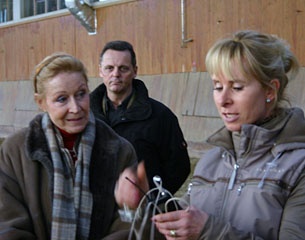
The Xenophon Classical Riding foundation was established some years ago to fight against undesirable developments in equestrian sport and to bring to mind the principles of the Classical School, which was developed by the old masters. Equestrian personalities such as Olympic gold medallists Klaus Balkenhol and Christine Stückelberger, Johann Riegler (the former Oberbereiter of the SRS in Vienna), Michael Putz, Dr. Gerd Heuschmann and others are committed to this aim.
Each year Xenophon hosts an international seminar with renowned trainers, dressage judges and representatives of veterinary medicine. This year it was held the last weekend of February in the Swiss town of Uster near Zurich and speakers included Olympic judges Beatrice Bürchler and Dr. Dieter Schüle, World Eventing Champion Bettina Hoy, Johann Riegler and Dr. Frank Schellenberger, one of the leading equine dentists.
Equine Dentistry
The seminar kicked off on Saturday morning with a series of lectures in the conference room of Uster Riding Club with guests from Germany, Switzerland and Austria. After Christine Stückelberger had welcomed the attendants Dr. Frank Schellenberger held an extremely interesting and descriptive lecture with the title "Equine dental medicine of today."
Schellenberger is a veterinary surgeon, who has specialized in equine dental medicine and has treated more than 16,000 horses to date, including several international sport horses.
At the beginning Dr. Schellenberger pointed out that some veterinary surgeons actually still claim horses cannot have tooth aches, though already 140 years ago the horses of the US- cavalry had to see an equine dentist annually. Schellenberger, who refines dentist's tools himself like for instance a dental bur, which isn't injuring the gums. He started his lecture with a short overview of the history of equine dental medicine, which seriously started in Germany about 70 years ago. In the sequel he concentrated on the different teeth and the specific problems they often cause.
The incisor tooth usually cannot be used as a criterion of age anymore because they are often corrected by an equine dentist. Schellenberger stressed this correction must fit in optimally to the cheek tooth: Thereby it is essential the horse is still able to close its mouth.
The infamous stallion tooth tends to become sharp and can injure the tongue so they should be shortened to the same length like the incisor tooth at the corners.
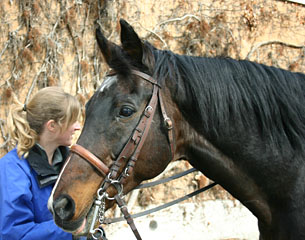 Gingival injuries are often caused by sharp cheek teeth („sharp points“). Schellenberger uses a mirror to get a good overview in the horse's mouth. Generally he recommended to check the horse's teeth once or twice a year, depending on age and condition. If there are bigger procedures to do the dentist should not do it all at once, otherwise the whole system would be effected.
Gingival injuries are often caused by sharp cheek teeth („sharp points“). Schellenberger uses a mirror to get a good overview in the horse's mouth. Generally he recommended to check the horse's teeth once or twice a year, depending on age and condition. If there are bigger procedures to do the dentist should not do it all at once, otherwise the whole system would be effected.
Schellenberger explained the necessity of sedation and local anaesthesia to minimize the danger of injury and lessen stress for the horses. A young horse should be treated for the first time latest before the breaking-in. Horse owners can prevent tooth problems by providing enough roughage. The modern type of cereal hard feed is less suitable to get the ideal wear on the teeth.
At the end of his excellent lecture Schellenberger took a look into the future of his specialized field: The diagnosis and tools will improve even more, the implantation of teeth will be possible and there will be better fillings for uncovered tooth nerves. Subsequently there were several questions from the audience and it became clear it is still not an easy thing to find a good equine dentist in every region of every country.
Bettina Hoy, the German Olympic medal winner, World- and European champion, who was in the audience prior to her own lecture, had an interesting question, asking how long the sedation can be found in the horse's blood if a horse should be treated not long before a show. Schellenberger answered that usually after 48, longest after 72 hours the sedation cannot be found anymore, but recommended not to treat the tooth before a show, if not urgently necessary.
Dressage Sport Through the Ages
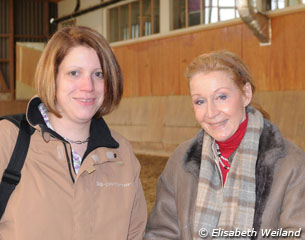
She illustrated the meaning of the horse in ancient times to support people's life in many different ways, be it the war or agricultural work before switching to the famous masters of the 20th century such as Wilhelm Müseler, Vladimir Littauer or Alois Podhaijsky. Stückelberger began with Müseler, who was a famous German riding instructor before World War II and wrote an indicatory riding manual called „Reitlehre“, which was first published in the 1930s and is still available and popular.
Müseler recognised the seat of the rider as the most essential factor of riding. For him only a supple seat leads to proper riding. But exactly this kind of seat is, to Stückelberger, rarely seen today because many riders do not take enough time to exercise the proper seat and try to compensate it with one of these modern dressage saddles, of which some squeeze the rider in a certain position.
Stuckelberger quoted Alois Podhajsky, the most famous leader of the SRS and an Olympic medal winner himself. Podhajsky's perception that a horse counterbalances itself upwards contradicts the way horses are trained in the rollkur position: "The FEI may have their opinion, but I am convinced rollkur is painful for the horses." Stückelberger stressed the importance of praising and encouraging horses in the daily training, referring to the great Vladimir Littauer, whom she values greatly.
To Littauer, a pioneer of forward riding, it was most important to award a horse by treating it justly, to allow it to have regular breaks, never to overask it and not to punish it if in doubt. Based on pictures of recent international dressage and jumping horses trained in the rollkur position Stückelberger requested the audience to refuse accepting this: "If you see horses being treated like that do not hesitate to contact the responsible steward. Horses ridden that way are extinguished and show typical stress musculature."
She finished her lecture with the refreshing picture of a Gelderland stallion, driven by a Hungarian. For Stückelberger this horse shows the happiness which is desirable in equestrian sport.
Bettina Hoy Delights the Crowds
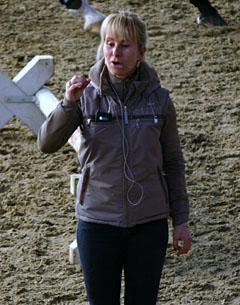 The almost Olympic Champion in three-day-eventing of 2004, Bettina Hoy, gave the last lecture on Saturday, talking about the winter training of the event horse and rider. Hoy is not only one of the most successful eventing riders of the past 30 years, but also an accomplished dressage rider. Her horses Ringwood Cockatoo and Woodsides Ashby won the dressage phase at Olympic and World Championships with record results.
The almost Olympic Champion in three-day-eventing of 2004, Bettina Hoy, gave the last lecture on Saturday, talking about the winter training of the event horse and rider. Hoy is not only one of the most successful eventing riders of the past 30 years, but also an accomplished dressage rider. Her horses Ringwood Cockatoo and Woodsides Ashby won the dressage phase at Olympic and World Championships with record results.
Generally it is important to assess the current level of riding and to set an aim before planning a varying basis program. Dressage training should prepare for the level asked in the upcoming season and the program should be practiced at some small shows before the first 3-day event of the season.
Bettina noted that many international event horses are trained to a higher lever in dressage than demanded in eventing to keep them interested and happy in their dressage work.
Bettina considers cavaletti work on a circle line very useful, also for the specialized dressage horse, as it improves the balance and the feeling for rhythm of both horse and rider. Dressage horses profit from it because they train different groups of muscles than usual.
Jumping training should not focus on the height, but on the fact that the horses keep their line in a supple way. Sometimes riders find it hard to see the right distance to an obstacle because the rhythm in which they approach it is wrong. Bettina recommended to count the canter strides loudly to get the rhythm. How well this works one could see later in her training session. To ride through water or even to jump into it, is always a challenge. After the winter Bettina gets all her horses, both young and experienced CCI**** ones, used to it again by first riding through the water in walk, then in trot. The horse must be used to it in such a way that it is nothing special if it appears in the cross country. Bettina and her husband, multiple Olympic Champion Andrew Hoy from Australia, train all their horses cross country a day prior to a show and this system works well as shown by their great success over the years.
To keep the event horse healthy Bettina explained it is important to work the horses on different surfaces, also uneven ones and to do canter and trot work on hills because it spares the legs and brings the heart and breathing rate faster to a higher rate than cantering on a racetrack. Bettina's horses have two fitness days a week, completed by dressage and jumping training. One day in the week the horses have a day "off", going out in the field or being hacked out. She stressed: "The horse is an animal used to walk long distances and we have to take this into account."
The horses not only have to be fit, but it is a duty of the rider to keep himself fit, too. Only then a rider is able to do the horse justice. Bettina stated that the level of fitness of a rider is crucial to his ability to be balanced in the saddle. So a rider has to work in different ways to get a stabilizing musculature which enables him to keep the balance and avoid taken hold of the reins and thereby disturbing the horse. Bettina confirmed she has made good progress with pilates and road work, but she also considers cycling and swimming or a fitness studio to be very useful. A physiotherapist can also be hopeful.
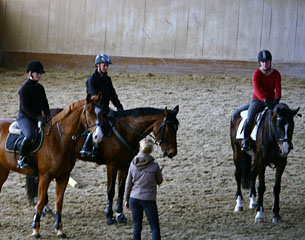 After a lunch break the seminar continued with the practical part in the nice indoor arena.
After a lunch break the seminar continued with the practical part in the nice indoor arena.
It started with a demonstration by Bettina Hoy how to train event horses in the winter. Four riders and their horses from Switzerland took part in this training and showed different problems which Bettina was able to improve in an impressive way within the time frame of 90 minutes. She proved that one does not need a lot of expensive equipment to train effectively. Some coloured plastic barrels, plastic blocks, poles and cavalettis are enough to build a useful training track if it is done in a clever way like Bettina demonstrated. The phase of warming up started with quiet trot work, in which the rider should establish light rein contact. After the warming up Bettina started with some cavalettis on a slightly curved line. Here the audience could see how hard it was for some horses to hold the rhythm or to use their backs while trotting over them.
Bettina stressed the importance of a steady, but light rein contact: "You should only feel the angles of the mouth!" One horse tried to hollow away from the leg and refused such a steady rein contact from the beginning as a result of suppleness problems. She advised the rider not to do too little in the beginning and then too much, but to achieve this important steady contact. Though a single training session is not able to solve such a problem the rider was able to improve thanks to Bettina's constructive help. When the horses started to jump they went over a single obstacle first, later they jumped a double. To check the obedience to the aids Bettina later removed the racks and even the poles so the horses had to jump a narrow plastic block. A rather small 19-year old grey thrilled the audience since her horse was jumping with a nice forward rhythm even the narrowest jumps with great confidence and joy. This excellent demonstration excited the audience and the riders alike since Bettina is a sharp observer who is honest in her training and has very good and easy solutions for different problems.
Training the Young Horse
The next demonstration, „The basic training of the young horse“ was given by the Olympic dressage judges Dr. Dieter Schüle, Béatrice Bürchler and Oberbereiter Johann Riegler. It featured two horses from Christine Stückelberger's stable, a 5 and a 6 year old.
The younger horse was a sympathetic chestnut by Stückelberger's former Grand Prix horse Ramiro's Bube (by Ramiro x Pik Bube I) which had a problematic youth before joining her stable last year. On arrival at her stable the horse showed aggressive behaviour but patient and correct training and treatment improved him in a way he could take part in the seminar. For the first away since his arrival at Stückelberger's yard the gelding was a bit nervous and tense, but full of faith in his young rider, 19-year old German Jasmin Shanti, who is training with Stückelberger.
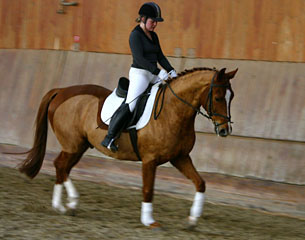 She rode „Denver“ on big circle lines to establish a soft rein and leg contact which was considered essential to Riegler, Bürchler and Schüle. Riegler pointed out that the calf should not clamp on the horse, but just hang down loosely. The legs are there to give short impulses together with the seat, but not to squeeze the horse forward all the time.
She rode „Denver“ on big circle lines to establish a soft rein and leg contact which was considered essential to Riegler, Bürchler and Schüle. Riegler pointed out that the calf should not clamp on the horse, but just hang down loosely. The legs are there to give short impulses together with the seat, but not to squeeze the horse forward all the time.
Stückelberger, who observed her horse closely, added: „A horse blocks if the calf clamps. Many riders must learn how little is necessary to ride a horse sensitively.“
Stückelberger's second horse was the stunning 6 year old Rhinelander stallion Rapallo (by Riccione), a horse with elastic and ground covering movements. He was ridden by the talented Austrian Manuel Springhetti who has started his apprenticeship at Stückelberger and her trainer Georg Wahl only last autumn. Riegler explained that the mobility of the central posture is decisive for a good seat because the rider should ideally give fine impulses with it. Dr. Schüle advised to ride the horse forward more steadily and with closed fists because the hands have a softer effect then. Stückelberger reminded the audience how import it is to pay enough attention to the scale of training while working with horses and to check if you fulfil the steps regularly.
Georg Fink on Calmness
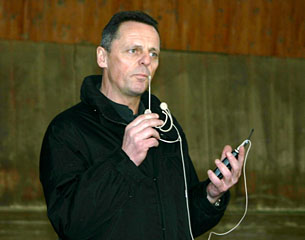 The seminar continued on Sunday with a lecture by Georg Fink about "Calmness" in which he stressed that calmness is a disposition in every discipline and absolutely necessary to train horses properly. Based on old films from former Olympic Games Christine Stückelberger he demonstrated how the dressage sport has changed over the past decades. It was interesting to see that these horses of the past move more naturally even though the quality of the horses could not be compared with the athletes of today.
The seminar continued on Sunday with a lecture by Georg Fink about "Calmness" in which he stressed that calmness is a disposition in every discipline and absolutely necessary to train horses properly. Based on old films from former Olympic Games Christine Stückelberger he demonstrated how the dressage sport has changed over the past decades. It was interesting to see that these horses of the past move more naturally even though the quality of the horses could not be compared with the athletes of today.
The next discussion about the ideal position of the horse's neck produced the conclusion that every horse is different and a rider has to consider this while riding, but that a tight neck is to be avoided.
The seminar came to an end with the projection of competition rides at novice, L- and M- level, which were judged by the audience and commentated by Béatrice Bürchler, Dr. Schüle and Johann Riegler. It revealed that judging is more difficult than many suppose and it highlighted the complexity of the job, which is often criticised.
Text and Photos by Silke Rottermann
Related Links
Xenophon at Landgestut Marbach
Xenophon at 2007 Equitana
Training With a Master: Georg Wahl
Christine Stückelberger: From Equestrian Super Star to Ambassador of Classical Dressage